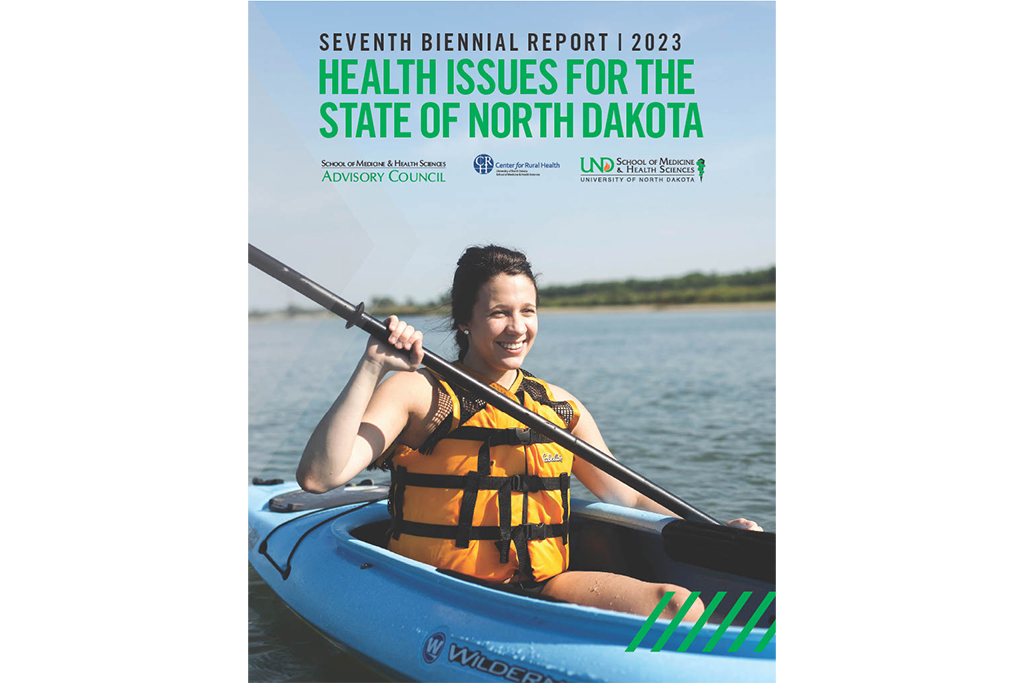The state of the state’s health
UND releases Seventh Biennial Report on Health Issues for the State of North Dakota

As the North Dakota Legislative Assembly continues its 68th gathering, the UND School of Medicine & Health Sciences and its partners has released the Seventh Biennial Report on Health Issues for the State of North Dakota report.
This report, required of the School per North Dakota Century Code, updates legislators on the current state of the health of North Dakotans and their healthcare delivery system, along with an analysis of the steps the state can take to ensure that all North Dakotans can access high-quality healthcare at an affordable cost now and in the future.
“Our first Biennial Report was prepared during the 2009-11 biennium and released just prior to the start of the 62nd Legislative Assembly,” recalled Dr. Joshua Wynne, dean of the SMHS and vice president for health affairs at UND. “A total of six reports have been released every two years since then, with the just-released update dated 2023.”
Healthcare workforce
According to Wynne, this latest report, coming on the heels of the worst global pandemic in a century, arrives a pivotal time for health and healthcare in North Dakota.
“It goes without saying that COVID put our state’s health and healthcare system to the test over the past two years,” he continued. “Not only in how it affected our population and its access to care, but our healthcare workforce.”
For a state already grappling with not only a shortage of healthcare providers but a maldistribution of those providers, said Wynne, COVID hit many rural hospitals and clinics especially hard. As the report notes, the pandemic exacerbated “burnout” across health professions, resulting in early retirements and resignations among some providers — thus a greater shortage overall — at the same time as it increased workloads for those physicians, nurses, and therapists who remained in their professions.
The need for healthcare workers is particularly important in rural and western parts of North Dakota, where there has been a chronic shortage especially of primary care providers for many decades, notes the report’s Executive Summary: “Without direct intervention, the difficulty of providing adequate healthcare in North Dakota will worsen over the coming decades from the aging of the population (including aging and eventual retirement of the healthcare workforce), which will increase the demand for healthcare services in those areas.”
Even so, the healthcare workforce news is generally good for North Dakota, said the Report’s lead author Mandi-Leigh Peterson, senior research analyst with UND’s Center for Rural Health.
“North Dakota’s efforts to train our own appears to be working,” Peterson said. “In previous Reports, North Dakota has had fewer physicians per capita than our Midwest and U.S. peers. While this still holds true, we have narrowed the gap in the provider-to-population ratios. Another area where we’re going in the right direction is that we’ve seen an increase in the number of health professionals in the state. The number of in-state graduates practicing in the state has gone up as well.”
Population health
Such positive trends carryover to the overall health of North Dakotans, Peterson continued. This latest Report suggests that, COVID notwithstanding, the health of North Dakotans seems to be improving.
“Prior to the pandemic, North Dakota was showing varied trends in health behaviors with improvements being seen in areas over time that suggested positive behavior changes,” Peterson said. “And according to national data, North Dakotans now are more likely to report good general health compared to the U.S.”
For example, the percentage of survey respondents who report smoking, binge drinking, and drinking and driving are all down relative to 2019, according to the Report. And up in the past few years is the percentage of North Dakotans who wear a seatbelt regularly.
Accordingly, the percentage of North Dakotans who report merely “fair” or “poor” health is down nearly two percentage points since 2019.
Health education
One notable fact from the Report, added Peterson, was the university system’s stunning response to the pandemic. The SMHS, UND’s College of Nursing & Professional Disciplines, and the NDSU College of Pharmacy all executed overwhelming programmatic and curriculum changes quickly in order to continue to provide the highest quality educational opportunities for students, despite the challenges of in-class cancellations and overall system uncertainty.
“The programs were able to provide opportunities for students to complete their curriculum and graduate on schedule to join the workforce at a critical time,” she said, highlighting UND’s Master of Public Health program in particular for its efforts. From April 2020 to June 2022, MPH faculty, students, and staff used funding provided by the North Dakota Department of Health & Human Services to send more than 180 case investigators to work 80,113 hours in an effort to combat the spread of COVID.
“The MPH program’s contributions to the contact-tracing efforts in the state were a very important asset that served the entire state,” Peterson said. “An additional notable piece was the collaborative response regionally by public health, health systems, and organizations to coordinate large scale vaccination efforts to ensure that vaccines were available to the public in a highly organized and efficient manner.”
In the end, both Wynne and Peterson suggest, the health picture, while not perfect, is improving in North Dakota.
“A few years ago, Gov. Doug Burgum asked me to head up a working group charged with developing a Strategic Plan for Health for the state of North Dakota, with the goal of making North Dakotans the healthiest people in the country,” concluded Wynne. “We have since turned that plan over to the North Dakota Department of Health and Human Services and State Health Officer Dr. Nizar Wehbi. And as these new data from this Report suggest, although we have a long way to go in achieving this bold goal, North Dakota is moving in the right direction.”


